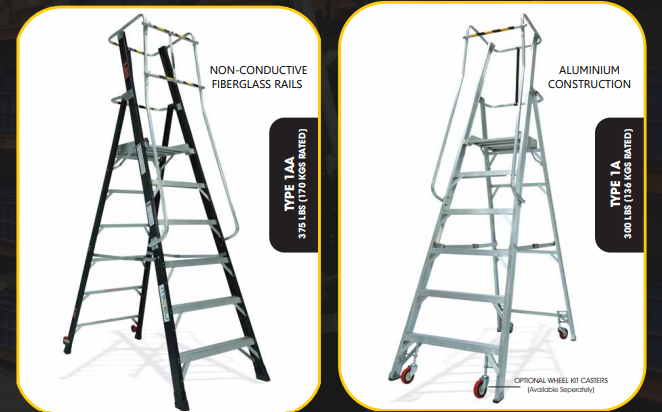Manufacturing aluminum ladders involves several key steps, from sourcing materials to quality control. Here's an overview of the process: Material Selection: Aluminum alloy is the primary material used for manufacturing aluminum ladders due to its lightweight nature and durability. High-quality aluminum with suitable alloy compositions is sourced from suppliers. Extrusion: The first step in manufacturing aluminum ladders is extruding aluminum profiles. This involves forcing heated aluminum billets through a shaped die to create the desired cross-sectional shape of the ladder's components, such as the rails and steps. Cutting and Machining: Once the aluminum profiles are extruded, they are cut to the required lengths and machined to precise dimensions. This may involve processes such as drilling holes for rivets or screws, shaping the ends of rails, and milling steps for ladder rungs. Assembly: The machined aluminum components are then assembled into ladder structures. This typically involves joining the rails and steps using rivets, screws, or welding techniques. Specialized fixtures and jigs may be used to ensure accurate alignment during assembly. Surface Treatment: After assembly, the aluminum ladder may undergo surface treatment processes to enhance its appearance and durability. Common surface treatments include anodizing or powder coating to provide corrosion resistance and improve aesthetics. Quality Control: Throughout the manufacturing process, rigorous quality control measures are implemented to ensure that the aluminum ladders meet safety standards and performance requirements. This may involve dimensional inspections, load testing, and visual inspections of surface finishes. Packaging and Shipping: Once quality control checks are completed, the finished aluminum ladders are packaged according to customer specifications and prepared for shipping to distribution centers or directly to customers. Regulatory Compliance: Manufacturers must ensure that their aluminum ladders comply with relevant safety standards and regulations, such as those set by organizations like OSHA (Occupational Safety and Health Administration) or ANSI (American National Standards Institute). Compliance with these standards is essential to ensure the safety of end-users.
Chat with us on WhatsApp
×
This is your website preview.
Currently it only shows your basic business info. Start adding relevant business details such as description, images and products or services to gain your customers attention by using Boost 360 android app / iOS App / web portal.

2024-05-09T09:40:29
Manufacturing aluminum ladders involves several key steps, from sourcing materials to quality control. Here's an overview of the process: Material Selection: Aluminum alloy is the primary material used for manufacturing aluminum ladders due to its lightweight nature and durability. High-quality aluminum with suitable alloy compositions is sourced from suppliers. Extrusion: The first step in manufacturing aluminum ladders is extruding aluminum profiles. This involves forcing heated aluminum billets through a shaped die to create the desired cross-sectional shape of the ladder's components, such as the rails and steps. Cutting and Machining: Once the aluminum profiles are extruded, they are cut to the required lengths and machined to precise dimensions. This may involve processes such as drilling holes for rivets or screws, shaping the ends of rails, and milling steps for ladder rungs. Assembly: The machined aluminum components are then assembled into ladder structures. This typically involves joining the rails and steps using rivets, screws, or welding techniques. Specialized fixtures and jigs may be used to ensure accurate alignment during assembly. Surface Treatment: After assembly, the aluminum ladder may undergo surface treatment processes to enhance its appearance and durability. Common surface treatments include anodizing or powder coating to provide corrosion resistance and improve aesthetics. Quality Control: Throughout the manufacturing process, rigorous quality control measures are implemented to ensure that the aluminum ladders meet safety standards and performance requirements. This may involve dimensional inspections, load testing, and visual inspections of surface finishes. Packaging and Shipping: Once quality control checks are completed, the finished aluminum ladders are packaged according to customer specifications and prepared for shipping to distribution centers or directly to customers. Regulatory Compliance: Manufacturers must ensure that their aluminum ladders comply with relevant safety standards and regulations, such as those set by organizations like OSHA (Occupational Safety and Health Administration) or ANSI (American National Standards Institute). Compliance with these standards is essential to ensure the safety of end-users.
2024-05-09T09:40:29
Keywords
- american national standards institute
- rigorous quality control measures
- manufacturing aluminum ladders
- suitable alloy compositions
- surface treatment processes
- common surface treatments
- finished aluminum ladders
- relevant safety standards
- performance requirements
- heated aluminum billets
- customer specifications
- dimensional inspections
- quality control checks
- cross-sectional shape
- manufacturing process
- regulatory compliance
- health administration
- high-quality aluminum
- specialized fixtures
- corrosion resistance
- distribution centers
- occupational safety
- aluminum components
- lightweight nature
- material selection
- precise dimensions
- welding techniques
- accurate alignment
- visual inspections
- several key steps
- ladder structures
- aluminum profiles
- primary material
- aluminum alloy
- milling steps
- manufacturers
- organizations
- load testing
- ladder rungs
- regulations
- appearance
- aesthetics
- durability
- first step
- machining
- packaging
- customers
- end-users
- extrusion
- suppliers
- materials
- anodizing
- shipping
- overview
- assembly
- sourcing
- cutting
- coating
- screws
- powder
- rivets
- shaped
- holes
- rails
- jigs
- ends
- osha
- ansi
- die

Submit Your Enquiry